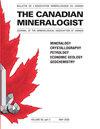Structure Topology and Graphical Representation of Decorated and Undecorated Chains of Edge-Sharing Octahedra
IF 1.5
4区 地球科学
Q3 MINERALOGY
引用次数: 1
Abstract
Infinite chains of edge-sharing octahedra occur as fundamental building blocks (FBBs) in the structures of several hundred mineral species. Such chains consist of a backbone of octahedra to which decorating polyhedra may be attached. The general, stoichiometric formula of such chains may be written as c[MATxФz] where M is any octahedrally coordinated cation, T is any cation coordinated by a decoration polyhedron (regardless of coordination geometry), Ф is any possible ligand [O2–, (OH)–, (H2O), Cl–, or F–], and c indicates the configuration of backbone octahedra. In the minerals in which they occur, these types of chains will commonly (though not exclusively) form part of the structural unit (i.e., the strongly bonded part) of a mineral. Hence, investigating the topology, configuration, and arrangement of such chains may yield fundamental insights into the stability of minerals in which they occur. A discussion of the topological variability of chains is presented here, along with the formulae necessary for their characterization. It is shown that many aspects of chain topology can be efficiently communicated by a pair of values with the form ([x], [Bopqrst]), where [x] summarizes the symmetry operations necessary to characterize the configuration of backbone octahedra, B indicates the length of the topological repeat, and o through t indicate the number of individual decorations (related to B). A methodology for developing finite graphical representations for infinite chains is presented in detail, showing that for any given chain, a single, irreducible finite graph exists that contains all topological information. Such a graph, however, can correspond to multiple chain topologies, highlighting the importance of geometrical isomerism. The utility of the graphical approach in facilitating the development of a hierarchy of chains and chain-bearing structures is also discussed.边共享八面体的装饰链和未装饰链的结构拓扑和图形表示
在数百种矿物的结构中,共享边缘的八面体的无限链是基本的构建块(FBB)。这种链由八面体的骨架组成,装饰多面体可以连接到八面体上。这种链的一般化学计量式可以写成c[MATxФz],其中M是任何八面体配位的阳离子,T是由装饰多面体配位的任何阳离子(无论配位几何结构如何),Ф是任何可能的配体[O2-,(OH)-,(H2O),Cl-,或F-],c表示骨架八面体的构型。在它们出现的矿物中,这些类型的链通常(尽管不是唯一)形成矿物结构单元的一部分(即强结合部分)。因此,研究这些链的拓扑结构、配置和排列可能会对它们所在矿物的稳定性产生根本的见解。本文讨论了链的拓扑可变性,并给出了表征链的必要公式。结果表明,链拓扑的许多方面可以通过一对形式为([x],[Bopqrst])的值有效地进行通信,其中[x]总结了表征主链八面体构型所需的对称运算,B表示拓扑重复的长度,o到t表示单个装饰的数量(与B相关)。详细介绍了一种开发无限链有限图形表示的方法,表明对于任何给定的链,都存在一个包含所有拓扑信息的单不可约有限图。然而,这样的图可以对应多个链拓扑,突出了几何异构的重要性。还讨论了图形方法在促进链和链承载结构层次结构发展方面的效用。
本文章由计算机程序翻译,如有差异,请以英文原文为准。
求助全文
约1分钟内获得全文
求助全文
来源期刊

Canadian Mineralogist
地学-矿物学
CiteScore
2.20
自引率
22.20%
发文量
45
审稿时长
4-8 weeks
期刊介绍:
Since 1962, The Canadian Mineralogist has published papers dealing with all aspects of mineralogy, crystallography, petrology, economic geology, geochemistry, and applied mineralogy.
 求助内容:
求助内容: 应助结果提醒方式:
应助结果提醒方式:


